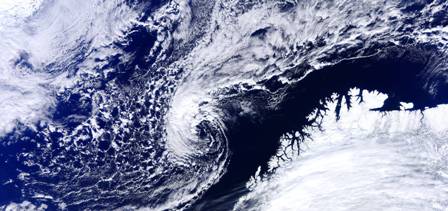Dec 17 2012
Intense but small-scale polar storms could make a big difference to climate predictions according to new research from the University of East Anglia and the University of Massachusetts.
 Picture credit: NEODAAS / University of Dundee
Picture credit: NEODAAS / University of Dundee
Difficult-to-forecast polar mesoscale storms occur frequently over the polar seas, however they are missing in most climate models.
Research published today in Nature Geoscience shows that their inclusion could paint a different picture of climate change in years to come.
Polar mesoscale storms are capable of producing hurricane-strength winds which cool the ocean and lead to changes in its circulation.
Prof Ian Renfrew, from UEA's School of Environmental Sciences, said: "These polar lows are typically under 500 km in diameter and over within 24-36 hours. They're difficult to predict, but we have shown they play an important role in driving large-scale ocean circulation.
"There are hundreds of them a year in the North Atlantic, and dozens of strong ones. They create a lot of stormy weather, strong winds and snowfall – particularly over Norway, Iceland, and Canada, and occasionally over Britain, such as in 2003 when a massive dump of snow brought the M11 to a standstill for 24 hours.
"We have shown that adding polar storms into computer-generated models of the ocean results in significant changes in ocean circulation - including an increase in heat travelling north in the Atlantic Ocean and more overturning in the Sub-polar seas.
"At present, climate models don't have a high enough resolution to account for these small-scale polar lows.
"As Arctic Sea ice continues to retreat, polar lows are likely to migrate further north, which could have consequences for the 'thermohaline' or northward ocean circulation – potentially leading to it weakening."
Alan Condron from the University of Massachusetts said: "By simulating polar lows, we find that the area of the ocean that becomes denser and sinks each year increases and causes the amount of heat being transported towards Europe to intensify.
"The fact that climate models are not simulating these storms is a real problem because these models will incorrectly predict how much heat is being moved northward towards the poles. This will make it very difficult to reliably predict how the climate of Europe and North America will change in the near-future."
Prof Renfrew added: "Climate models are always improving, and there is a trade-off between the resolution of the model, the complexity of the model, and the number of simulations you can carry out. Our work suggests we should put some more effort into resolving such storms."